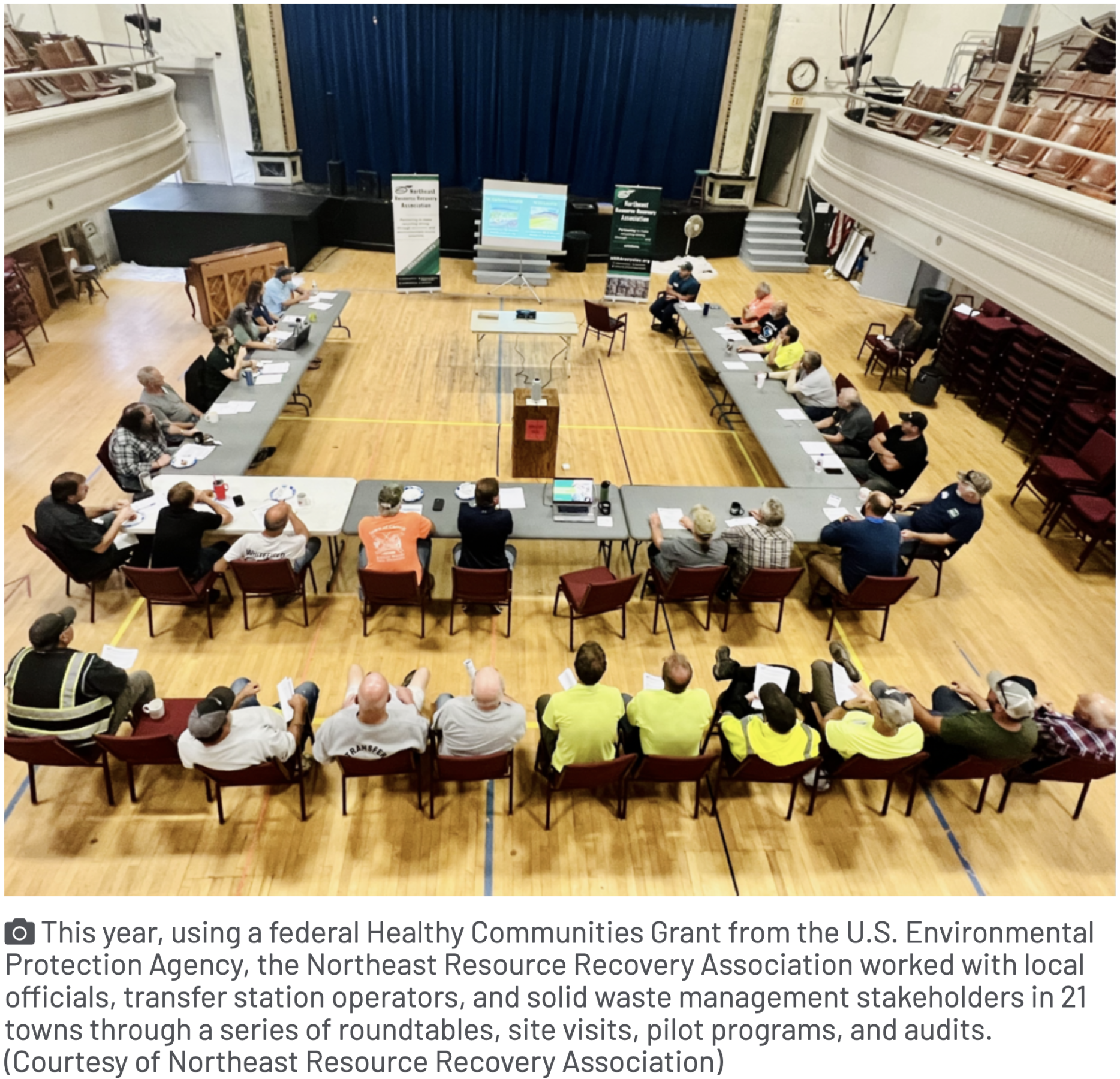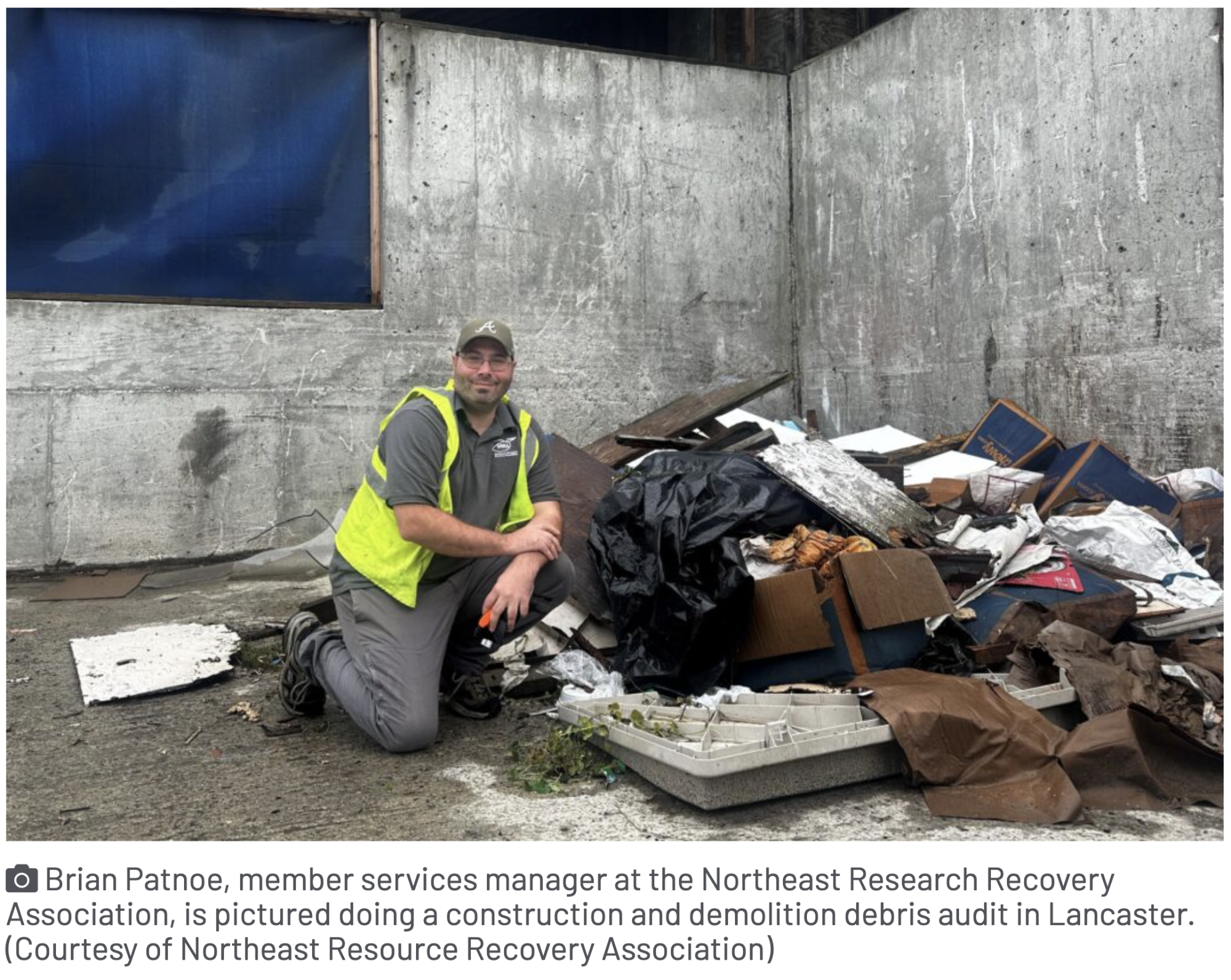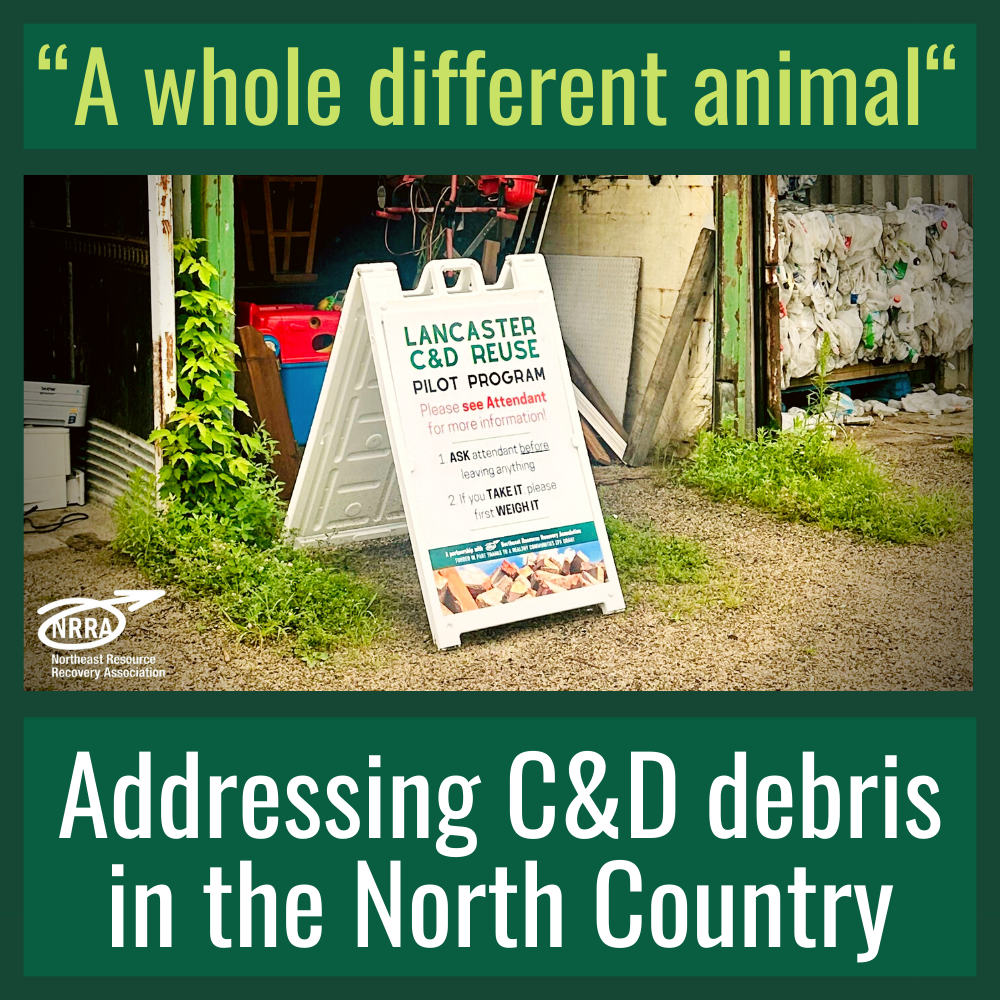‘A whole different animal’: Addressing construction and demolition debris in the North Country
by Hadley Barndollar, New Hampshire Bulletin
Coos County’s Mount Carberry Landfill took in more than 162 million pounds of construction and demolition debris in 2021. That, according to the Northeast Resource Recovery Association, means the disposal of wood, metal, sheet rock, shingles, asphalt, brick, and concrete was more than twice the amount of food waste landfilled there that same year.
Construction and demolition debris is often an overlooked contributor to landfill waste, said Reagan Bissonnette, executive director at the NRRA, and in the North Country, it’s an environmental justice issue.
This year, using a federal Healthy Communities Grant from the U.S. Environmental Protection Agency, NRRA worked with local officials, transfer station operators, and solid waste management stakeholders in 21 towns through a series of roundtables, site visits, pilot programs, and audits. The award of a second grant will expand construction and demolition debris diversion work in the North Country, narrowing in on Coos County and northern Grafton County.
“It’s really a huge issue,” said Bissonnette. “In New Hampshire, the vast majority of construction and demolition debris is landfilled, and it takes up a meaningful amount of space.”
 Nationally, data shows the country generates twice as much construction and demolition debris as it does municipal solid waste, the latter of which usually gets the attention in most communities when it comes to diversion efforts. That’s because municipal solid waste is easier to separate, experts say, while construction and demolition debris is a mixed waste stream that can be difficult to salvage from – picture trying to reuse materials that were demolished by a bulldozer, for example.
Nationally, data shows the country generates twice as much construction and demolition debris as it does municipal solid waste, the latter of which usually gets the attention in most communities when it comes to diversion efforts. That’s because municipal solid waste is easier to separate, experts say, while construction and demolition debris is a mixed waste stream that can be difficult to salvage from – picture trying to reuse materials that were demolished by a bulldozer, for example.
“C&D is a whole different animal,” said Michael Nork, a supervisor in the solid waste management division at the state’s Department of Environmental Services. “It’s not homogenous. There’s so many places where it is generated.”
According to New Hampshire’s updated solid waste plan published last year, the state is looking at municipal solid waste and construction and demolition debris as equally important, with the goal of cutting both by 25 percent by 2030 and 45 percent by 2025.
“This overarching goal applies to all MSW and C&D disposed in New Hampshire’s landfills and incinerators, regardless of the source or state of origin,” the plan says.
For more than a decade, Massachusetts has prohibited disposal of wood, clean gypsum wallboard, asphalt, pavement, brick, and concrete. A lot of that heads north to New Hampshire, where more than 50 percent of waste entering landfills originated from out of state.
There aren’t any local construction and demolition debris recycling facilities in the North Country, and the closest are in southern New Hampshire and western Vermont. Between out-of-state waste and not many nearby options for diversion, many North Country communities bear a disproportionate share of negative environmental consequences, said Bissonnette.
Successful Lancaster pilot program
With the EPA grants, NRRA is empowering communities to take waste matters into their own hands. One pilot project in Lancaster proved wildly successful.
The town had been trying to address construction and demolition debris at its transfer station. It had altered its fee structure to discourage people from disposing of that type of waste there, particularly “some of the contractors using us basically as their own landfill center,” said Benjamin Gaetjens-Oleson, Lancaster’s town manager.
The transfer station wasn’t equipped to handle contractors bringing in large amounts of debris, and the same is true for smaller communities all across the state. Many transfer station websites specify that construction and demolition debris isn’t accepted, sending people to facilities in larger communities.
“We have a pretty vibrant and robust downtown area that in the last few years has seen a lot of redevelopment, so we’ve generated a lot of C&D waste coming into the facility, to the point we had to change our operations to accommodate that,” Gaetjens-Oleson said.
 As part of a pilot program with NRRA, for almost two months, Lancaster town staff set up a construction and demolition debris “reuse area” at their transfer station – featuring lumber, doors, windows, and other materials that could be repurposed, up for grabs for any resident or business.
As part of a pilot program with NRRA, for almost two months, Lancaster town staff set up a construction and demolition debris “reuse area” at their transfer station – featuring lumber, doors, windows, and other materials that could be repurposed, up for grabs for any resident or business.
During that time period, the town diverted 3,078 pounds of construction and demolition debris and bulky waste from Mount Carberry Landfill and saved about 15 percent of space in their hauling containers. The town also saved close to $200 in tipping fees and hauling costs over the course of 53 days.
In addition, it was calculated that 57.85 pounds of carbon dioxide emissions were avoided over the course of the Lancaster pilot program, based on the fuel savings by not hauling the weight of the diverted material, and not including the avoided greenhouse gas emissions that result from landfilling.
Gaetjens-Oleson said the pilot was a welcome addition to their operations and one they expect to continue.
‘Deconstruction’ and diversion
NRRA’s next EPA grant round is expected to address the idea of “deconstruction,” which refers to contractors taking a slower approach to taking apart a building or structure and salvaging items that could be reused, instead of tearing it down with heavy equipment.
Bissonnette said Vermont has done “great work to support deconstruction in the state,” for example.
Deconstruction is also referenced in the state’s solid waste plan, specifically as an action item to reduce generation of construction and demolition debris. But it’s easier said than done, said Nork, from DES.
“When construction and demolition projects happen, time is money, so there’s not always a lot of care at the site level to really think about how to prepare the waste so it is easier to recover downstream,” he said, noting that “upstream generators” aren’t part of his department’s regulatory scope at this time, making it difficult for them to have much influence on the front end of waste generation.
In light of that, Nork said, “we definitely need more processing infrastructure.”
Resource Waste Services, for example, with New Hampshire facilities in Epping and Salem, is New England’s largest recycler of construction and demolition debris. It processed 335,000 tons in 2020, with approximately 79 percent of the material being recycled, recovered, or beneficially reused.
The saved materials provide wood fuel for electricity generation, fiberboard manufacturing, new cardboard, drywall, recycled plastic and metal products, asphalt paving, and other construction materials and soil substitutes.
“One of the conversations we’ve had internally here at the department is it would be great to see more of those facilities developed,” said Nork.
This story was originally written and published by New Hampshire Bulletin, which is part of States Newsroom, a network of news bureaus supported by grants and a coalition of donors as a 501c(3) public charity. New Hampshire Bulletin maintains editorial independence. Contact Editor Dana Wormald for questions: info@newhampshirebulletin.com. Follow New Hampshire Bulletin on Facebook.
